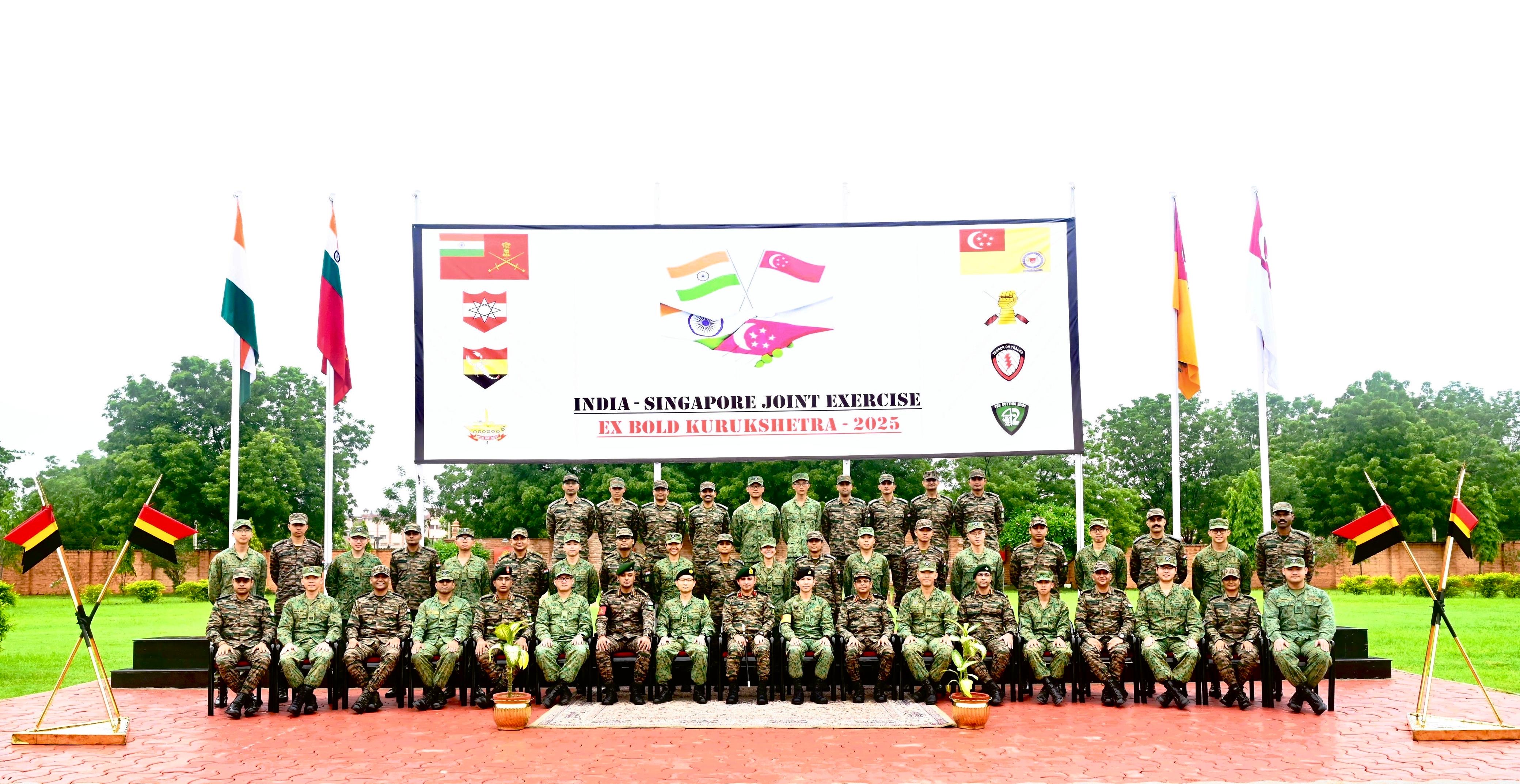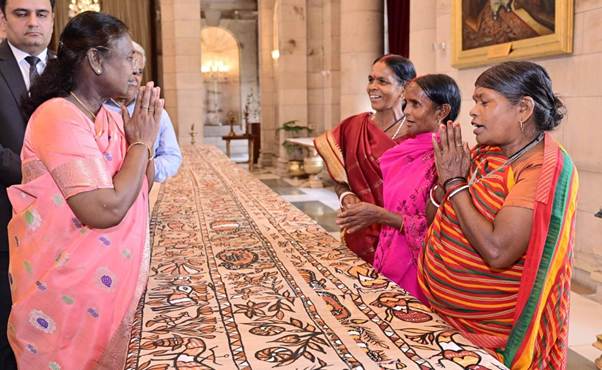Exercise Bold Kurukshetra 2025

- 28 Jul 2025
In News:
The 14th edition of Exercise Bold Kurukshetra was commenced in Jodhpur, Rajasthan, reinforcing India–Singapore military ties. This bilateral military exercise is a key component of both countries’ growing defence cooperation.
About Exercise Bold Kurukshetra:
|
Feature |
Description |
|
Type |
Bilateral joint military exercise |
|
First Initiated |
2005 |
|
Edition |
14th edition (2025) |
|
Location (2025) |
Jodhpur, Rajasthan |
|
Duration |
28 July – 4 August 2025 |
|
Format |
Tabletop Exercise and Computer-Based Wargame |
|
Objective |
Enhance interoperability, validate mechanised warfare tactics, and simulate UN peacekeeping operations |
Participating Contingents:
|
Country |
Unit/Regiment |
|
India |
Mechanised Infantry Regiment |
|
Singapore |
42nd Armoured Regiment, 4th Singapore Armoured Brigade |
Key Features:
- Mechanised Warfare Focus: Validates joint operational tactics in modern armoured and mechanised operations.
- UN Mandate Simulation: Exercises conducted under simulated Chapter VII of the UN Charter, preparing both armies for peacekeeping and peace enforcement missions.
- Ceremonial Traditions: Enhances military camaraderie through shared symbolism and operational command handovers.
- Equipment Display: The exercise concludes with a display of Indian Army equipment, highlighting India's indigenous defence capabilities.
Strategic Significance:
|
Domain |
Contribution |
|
Defence Diplomacy |
Deepens bilateral military cooperation with Singapore |
|
Indo-Pacific Stability |
Enhances India’s strategic role in maintaining peace in the Indo-Pacific |
|
UN Peacekeeping |
Builds joint operational readiness for multinational UN-mandated missions |
|
Capacity Building |
Boosts joint planning and execution skills for mechanised combat environments |
Sohrai Art of Jharkhand

- 28 Jul 2025
In News:
Sohrai Art from Jharkhand was prominently showcased during Kala Utsav 2025 held at Rashtrapati Bhavan, where President Droupadi Murmu hailed it as reflecting the “soul of India.” The event marked a significant national recognition for this traditional tribal art.
About Sohrai Art:
|
Aspect |
Details |
|
Tribal Origins |
Practised by Santhal, Munda, and Oraon tribes in Jharkhand. |
|
Region |
Predominantly in Hazaribagh, Santhal Parganas, and parts of eastern Bihar. |
|
Occasion |
Ritual wall-painting during Diwali and harvest festivals. |
|
Purpose |
Thanksgiving for livestock and land fertility; linked to agrarian rituals and spiritual ecology. |
|
Artists |
Traditionally women; passed down through generations orally and practically. |
Key Features of Sohrai Art:
- Motifs: Stylized animals, birds, trees, and rural life, symbolizing harmony with nature.
- Materials: Uses natural pigments such as red ochre, white kaolin, yellow clay, and black manganese.
- Tools: Made with bamboo twigs, chewed sticks, and cloth instead of synthetic brushes.
- Cultural Essence: Embodies a blend of mythology, agrarian life, womanhood, and sustainability.
Kala Utsav 2025: National Recognition
- Held at Rashtrapati Bhavan as part of the Artists in Residence Programme.
- Ten tribal artists from Hazaribagh showcased their work to a national audience.
- President Murmu lauded the art as a symbol of India’s cultural depth and ecological consciousness.
Institutional Support: IGNCA’s Role
- Indira Gandhi National Centre for the Arts (IGNCA) and its Regional Centre in Ranchi coordinated artist participation.
- IGNCA continues to promote indigenous art forms, ensuring cultural preservation and artist recognition.
Cultural and Policy Relevance:
- Art & Culture: Highlights India’s rich tribal and folk heritage.
- Women Empowerment: Female-centric art practice promoting rural livelihoods.
- Sustainable Development: Use of eco-friendly materials and community-led traditions.
- Tribal Development Schemes: Aligns with objectives of schemes like TRIFED, GI tagging, and cultural promotion under Tribal Affairs Ministry.
Rajendra Chola I
- 28 Jul 2025
In News:
India is commemorating 1,000 years of Rajendra Chola I’s Southeast Asian expedition through cultural events and heritage projects.
Key Highlights:
Rajendra I Chola (r. 1014–1044 CE), son of Rajaraja I, was one of India’s most formidable monarchs, remembered for transforming the Chola Empire into a powerful naval and commercial force that extended influence far beyond the Indian subcontinent.
Background: Rise of the Chola Empire
- Imperial Cholas, based in Thanjavur, rose to prominence after Vijayalaya Chola captured the region around 850 CE.
- Successive rulers like Aditya I and Rajaraja I expanded the empire by defeating the Pallavas, Pandyas, and Rashtrakutas.
- Rajaraja I built the Brihadeeswarar Temple (1010 CE) and initiated overseas campaigns, laying the foundation for maritime expansion.
Rajendra I Chola’s Expansionist Vision
- Ascended the throne in 1014 CE, though anointed in 1012 CE.
- Sought to establish Chola supremacy across land and sea.
- Completed the conquest of Sri Lanka, capturing King Mahinda V and consolidating the southern frontier.
- Defeated the Western Chalukyas, Pandyas, Cheras, and Palas, earning the title Gangaikonda Chola (“the Chola who conquered the Ganges”).
New Capital – Gangaikondacholapuram
- To commemorate northern victories, Rajendra founded Gangaikondacholapuram, an imperial capital that served as a political, administrative, and cultural hub.
Naval Expeditions to Southeast Asia
Motivation:
- Establish maritime supremacy, protect trade routes, and forge strategic alliances.
- Respond to shifting alliances in Southeast Asia (Khmer Empire vs Srivijaya).
The Campaign (c. 1025 CE):
- Launched a massive naval expedition targeting the Srivijaya Empire (modern-day Indonesia, Malaysia).
- Conquered strategic regions like:
- Kadaram (Kedah)
- Pannai (Sumatra)
- Malaiyur (Malay Peninsula)
- Tambralinga, Pegu, and Kalingga
Significance:
- Asserted dominance over key trade routes to Song China.
- Cemented Chola-Khmer alliance.
- Extended Tamil commercial and cultural influence across Southeast Asia.
Commercial and Cultural Legacy
- Promoted merchant guilds such as Manigramam, Ayyavole, and Ainnurruvar, which flourished in overseas ports.
- Tamil inscriptions, artifacts, and temple architecture found across Indonesia, Malaysia, Cambodia, and China.
- Tamil loanwords persist in the Karo language of Sumatra.
- Contributed to a Tamil diaspora that influenced art, architecture, trade, and religion in Southeast Asia.
Military and Administrative Excellence
- Maintained a vast army and navy.
- Efficient administrative system with support from Krishnadeva Kendras (early research and extension centers).
- Built upon the model of divine kingship with Nataraja (Shiva as cosmic dancer) symbolizing spiritual legitimacy.
Global Recognition and Commemoration
- India’s training ship TS Rajendra, commissioned in 1972, honours his naval prowess.
- Chinese accounts from the 11th century describe the Chola court’s wealth, discipline, and grandeur.
- The Coromandel Coast derives its name from Cholamandala ("realm of the Cholas").
Conclusion
Rajendra I Chola stands out in Indian history as a maritime emperor, who not only expanded territorial frontiers but also projected Indian influence across Southeast Asia. His legacy lies in blending military conquests with trade diplomacy, and establishing cultural ties that endured for centuries. His reign marks one of the earliest and most successful examples of Indian soft power abroad.
Climate-Resilient and Organic Agriculture: Parliamentary Committee Report Highlights
- 28 Jul 2025
In News:
The Committee on Estimates (2024–25) has submitted its Sixth Report to Parliament, emphasizing the pressing need for a climate-resilient and ecologically sustainable agricultural system in India. The report presents a roadmap aimed at tackling the vulnerabilities posed by climate change, soil degradation, and unsustainable farming practices.
Key Challenges in Indian Agriculture:
1. Climate Vulnerability:
- Projected Yield Decline: Crop yields may fall by 4.5% to 9% in the medium term due to climate-induced stresses.
- District-Level Risks: Out of 310 climate-vulnerable districts identified by the IPCC,
- 109 are at ‘very high risk’,
- 201 are categorized as ‘highly vulnerable’.
2. Soil Health Crisis:
- Extent of Degradation: Nearly 30% of India's land suffers from soil degradation.
- Root Causes: Excessive chemical inputs (urea and pesticides) and loss of organic matter have disrupted nutrient cycles and reduced fertility.
3. Economic Pressures: The Green Revolution model now shows diminishing returns, with rising input costs contributing to farmer indebtedness and suicides.
Policy Shift Towards Sustainable Farming:
1. Natural Farming:
- National Mission on Natural Farming (NMNF): Launched in 2023–24 as an independent scheme, expanding upon the earlier Bhartiya Prakritik Krishi Paddati (BPKP).
- Focus: Chemical-free agriculture, soil regeneration, and farmer self-reliance.
2. Organic Farming Initiatives:
- Paramparagat Krishi Vikas Yojana (PKVY): Promotes cluster-based organic farming using Participatory Guarantee Systems (PGS) for certification.
- MOVCDNER: Aims to develop organic value chains in the North Eastern Region, leveraging traditional practices and rich biodiversity.
Challenges in Transition:
- Yield reductions during the initial switch.
- Complex and often expensive certification procedures.
- Weak market linkages and poor consumer awareness.
- Training and knowledge gaps among farmers.
- Financial risks for small and marginal farmers lacking safety nets.
Recommendations of the Committee:
- Integrate climate-resilient agriculture into national schemes like PM-KISAN, MGNREGA, and RKVY.
- Provide green subsidies to farmers offering ecological services.
- Establish a national agroecological transition framework combining research, training, and market access.
- Empower Krishi Vigyan Kendras (KVKs) with digital tools and decentralized funding for field-level implementation.
Scaling Up Climate-Resilient Strategies:
National Innovations in Climate Resilient Agriculture (NICRA):
- Launched: 2011 by the Indian Council of Agricultural Research (ICAR).
- Objective: Equip farming systems to adapt to climate variability.
Key Components:
- Strategic research on climate-tolerant varieties.
- Technology demonstrations in vulnerable districts.
- Capacity building for farmers and extension staff.
- Infrastructure enhancement at research institutions.
Notable Achievements in NICRA Villages:
- 2,900+ climate-resilient varieties developed (e.g., heat-tolerant wheat, drought-resistant rice).
- 28–37% rise in crop productivity.
- 10–12% increase in livestock productivity.
- 35–40% higher farm incomes compared to non-NICRA areas.
Way Forward:
- Expand NICRA initiatives to cover more vulnerable districts with dedicated funding.
- Create agroecological clusters to support localized natural/organic farming models.
- Simplify and support organic certification and branding to enhance marketability.
- Promote ministerial convergence among Agriculture, Environment, and Rural Development departments for cohesive implementation.
Environmental Flow (E-Flow) in Indian Rivers
- 28 Jul 2025
In News:
Union Jal Shakti Minister Shri C.R. Patil recently chaired a crucial meeting focused on the Environmental Flow (E-Flow) of the Ganga River and its tributaries, with particular attention to the Yamuna River. This initiative is a part of the broader effort to ensure the ecological sustainability of India’s river systems.
What is Environmental Flow (E-Flow)?
Environmental Flow refers to the quantity, timing, and quality of water flow necessary to sustain freshwater ecosystems and the livelihoods dependent on them. It ensures that rivers maintain their ecological integrity, supporting aquatic life, estuarine health, and human usage in a sustainable manner.
Why is E-Flow Important?
- Maintains ecological balance in rivers and estuaries.
- Supports aquatic biodiversity, especially key fish species.
- Provides long-term ecological and economic benefits.
- Balances human needs and environmental sustainability, especially in overexploited river basins.
Challenges in Maintaining E-Flow:
- Construction of dams and barrages.
- Pollution and urban encroachments.
- Over-extraction of water for agriculture and industry.
These interventions disrupt natural flow patterns, threatening riverine ecosystems and dependent communities.
Government Initiatives and Studies:
Environmental Flow Notification (2018):
- Introduced by the government to regulate minimum required flows in the Ganga. However, a review of its impact is now being undertaken to determine its effectiveness and the need for improvements.
Recent Meeting Outcomes:
- Emphasis on strengthening the e-flow framework, especially for the Yamuna River, which faces severe pollution and over-extraction issues.
- Need for a robust, inclusive, and scientific approach to water management.
Studies Approved Under National Mission for Clean Ganga (NMCG):
|
Institution |
Rivers/Sub-Basins Assigned |
|
NIH Roorkee |
Chambal, Son, Damodar |
|
IIT Roorkee |
Ghaghara, Gomti |
|
IIT Kanpur |
Kosi, Gandak, Mahananda |
These studies aim to assess current flow conditions and recommend sustainable flow levels.
Way Forward:
- Expedite assessments under NMCG and ensure multi-stakeholder participation.
- Develop comprehensive water flow strategies for heavily impacted rivers like the Yamuna.
- Strengthen decision-making frameworks to balance ecological and human needs.
